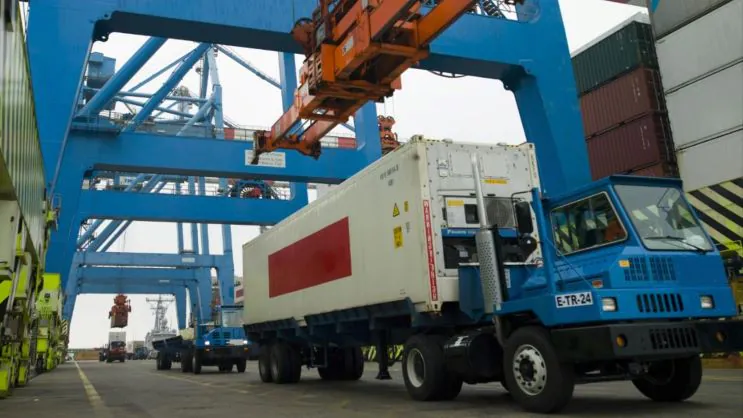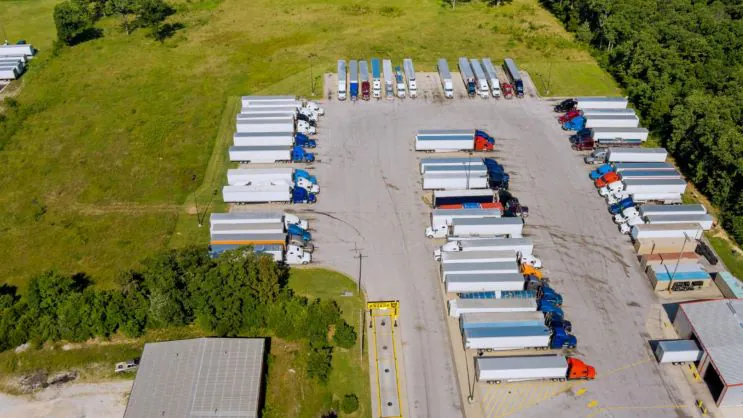Load and Transport Items Fast With Drayage Trucking
Understand the loading process, its impact on intermodal transportation, and the key considerations for efficient operations. Optimize your supply chain with expert knowledge for drayage and intermodal transport.

Source: www.canva.com
Load and transport drayage trucking: from warehouse stock to port, and the way around
Intermodal transport is constantly expanding. According to McKinsey & Company, logistics companies have started investing heavily in intermodal hubs, which is important in facilitating sustainable transportation modes. Shifting to intermodal transport isn’t a new trend, but now it’s also emerging from the need for sustainability. We can expect the share of container transport to grow, which has grown exponentially from 22% of global GDP to 59% in 2015 and keeps progressing.
Along with this, we see increased traffic on drayage transport (the transportation of shipping containers by truck to their final destination), which, in some cases, is the only way of delivering containers from the port to the warehouse. It’s important to note that rail networks almost never cover smaller industrial areas with rail hubs for intermodal transport. Therefore, we can observe that drayage truck movements are often used for “first or last mile” delivery. It is worth noting that using drayage transport as a vast part of intermodal transport still significantly reduces direct fuel-related costs. In the United States, fuel represents approximately 22% of trucking costs. Furthermore, we save on general shipping costs based on smart loading and short distances to the port. How exactly? Let us explain it in this article.
What is a drayage shipment?
A drayage shipment refers to a container that is being transported by a drayage truck with a trailer. In fact, drayage trucks are specialized vehicles designed to move containers between ports, but that can also be done by rail terminals. A huge number of drayage containers are transported through inland roads to distribution centers. The number of vehicles is growing, where for every 1% increase in global gross domestic product (GDP), there is an exact reference of a 1.2%–1.4% increase in international freight, which means that intermodal transport is becoming more and more critical.

Source: www.canva.com
Here are some key points outlined about drayage shipments
Types of containers: Drayage shipments can include both import and export containers. The size of the containers doesn’t play a role, as any size between 20ft to 40ft containers can be part of the drayage shipment. Drayage shipments typically follow standard container sizes and weight limits, but empty containers that are being repositioned can also be part of that.
Transportation: Drayage trucks use specialized equipment such as a chassis to transport containers. However, they are still fairly similar to normal trucks, and regular trucks can also handle drayage container transport.
Distance: Drayage shipments are usually transported over shorter distances than long-haul transportation. But this doesn’t mean you cannot transport them over distances of 100 km (62 miles).
What are container haulers?
Container haulers are specialized trucking companies that transport shipping containers between ports, rail terminals, and inland distribution centers. Here we’re talking about companies that are true experts in handling this part of intermodal shipping. We may say these container haulers are about trafficking containers, but rather they are on this unique trip from ports to warehouse docks and the way back.

Source: www.canva.com
As previously mentioned, the increase in demand for intermodal transport boils down to the increase in freight rates. Moreover, the rise in additional charges was intensified by port congestion, a temporary lack of containers, limited access to empty ones, etc. According to Statista, within a year, the net operating profits of container shipping operators in the years between 2020 and 2021 grew by over 73%. This significant increase shows that container haulers are getting better and better.
How do you load a drayage container?
The loading process starts in the warehouse. It’s essential to clarify the value of the proper container being loaded for drayage transportation. Each shipping container should be appropriately secured with well-settling pallets and secured cargo. Companies can provide a secured shipment of containers that comply with weight distribution demands.
The end-to-end container loading procedure can be described in the steps below:
Loading Procedure
- Positioning the Container: Companies use a straddle carrier or a reach stacker to position the empty container in the designated loading area.
- Securing the Container: The operator must ensure that the container is firmly secured to the ground to prevent movement during loading.
- Loading the Cargo: Before sealing the container, a final inspection is conducted to ensure that all cargo is securely fastened and there are no loose items.
Warehouse clerk: Outbound operations plan the layout of container loading on a dedicated platform to prevent issues with moving cargo and damaging it during transport.
Forklift Loading: A forklift driver following the loading report can start from smaller units and use a forklift to carefully load pallets or individual items into the container.
Straddle Carrier or Reach Stacker Loading: For larger items or bulk cargo, outbound operators need to use a straddle carrier or reach stacker to load the cargo directly into the container.
Manual Loading: If necessary, outbound workers need to follow the loading plan by manually loading goods into the container. They need to ensure that all units are evenly distributed and secured.
- Cargo Securing: Once the cargo is loaded, it’s time to use appropriate securing methods. These may include ratchet straps, chains, or airbags to prevent the cargo from shifting during transportation. Most outbound operators have instructions and loading software that help them manage all loading procedures step-by-step.
- Door Closure: The outbound team carefully closes and secures the container doors.
- Container to Port: A container is transported by container haulers to the port and unloaded from the trailer.
What platform should you choose to load containers for drayage transport?
The future of intermodal transport means that box sizes will be stable at today’s standards. It will give enormous investment requirements across the value chain to accommodate longer 53-foot or wider 8-foot 6-inch containers. This is the future so we must be ready to comply with much more than the loading restrictions of 40- and 20-foot containers.

Source: www.canva.com
Here are the most critical load planning platform features:
Space Utilization: The ability to calculate the remaining space in vehicles or containers, allowing the platform to more effectively ship your goods. This will help you estimate how much space you need.
Container Optimization suggests optimal container sizes based on cargo dimensions. In this case, you can predict which container to order before loading. You may need only a 20-foot container instead of a half-loaded 40-foot container. It all depends on the cost of the cargo.
Step-by-Step Load Plans: Load planning software provides detailed instructions for loading cargo efficiently. You can see all of the layouts and adhere to restricted norms if needed. Let’s not forget that loading dangerous goods and other materials requires special cargo load restrictions.
Weight Limit Compliance: This ensures adherence to weight limits, including axle weight distribution for whatever state you need by informing you if your cargo is exceeding the weight capacity based on the container’s dimensions. Let’s not forget that the shipment will depend on your needs and the shape of the cargo.
Weight Distribution Overview: The load planning platform can visualize weight distribution for better planning. You can see exactly where the heavier goods are going to be placed.
Potential Use Cases for a Load Planning Platform:
- Shipping Companies: Many freight forwarders use load planning software to optimize container utilization and reduce shipping costs.
- Warehouses: It is natural to efficiently plan truck and container loading in each warehouse and distribution center. As a result, they are frequent users of container load planning platforms.
- Manufacturers: In the supply chain, production facilities also use software for loading to ensure proper product packaging and loading.
Logistics Providers: All contracted logistics and fulfillment companies strive to manage transportation and storage operations more effectively. Therefore, they are also common users of load planning platforms.

Source: www.canva.com
Why would you use intermodal drayage?
Intermodal drayage offers several advantages for businesses involved in transportation:
- Cost-Effectiveness: It can be more cost-effective than solely relying on truck transportation for long distances. That is visible, especially for shipments moving between ports and inland locations.
- Efficiency: Intermodal drayage combines the strengths of different modes of transportation such as rail’s long-haul capabilities and trucking’s flexibility. This definitely results in faster and more efficient deliveries.
- Reduced Emissions: Utilizing multiple modes of transportation and intermodal drayage can help reduce carbon emissions and improve sustainability.
- Access to Wider Markets: It enables businesses to reach a broader range of markets by connecting to different transportation networks. Don’t forget what we said: a huge amount of products are transported without a rail network.
- Improved Supply Chain Management: Intermodal drayage can help streamline supply chain operations by providing a more integrated and efficient transportation solution.
Why is shipping with drayage services a good intermodal strategy?
Drayage requires trucks, but these trucks can travel short distances. For the most part, it only covers the distance between ports and warehouses and vice versa. Therefore, if trucks are replaced with green trucks, which means electric vehicles, energy consumption will be far less. Since we are on the subject of electric vehicles; electric vehicles are very sustainable, as are electric trucks for short distances. They can travel up to 600 km (370 miles) without needing to charge. By having electric trucks, you fulfill intermodal transport and make it even more sustainable.

Source: www.canva.com
Many may not know that recent research has shown that the logistics industry can reduce local pollutants anywhere from 41 to 63% by prioritizing the cleanest truck carriers in use. This number is significantly high. By prioritizing green drayage transport, you can deploy strategies that make transport more efficient. For example, when looking at intermodal modes of transport, we can see that conventional scenarios cover land transport, such as road transit, rail, and marine transport. If you implement green trucks, they will reduce energy consumption and CO2 emissions by more than 50%. This is because, as stated in recent research: Toward Greener Supply Chains by the International Council on Clean Transportation, equipment strategies generate major input for total reduction.
Summary
In brief conclusion, intermodal drayage offers a valuable solution for businesses seeking efficient, cost-effective, and sustainable transportation options. If you combine the strengths of rail and trucking, intermodal drayage can help streamline supply chains. It all boils down to improving overall business operations.
If you’re ready to explore the benefits of intermodal drayage for your business to have efficient loading, check out our load planning platform. Contact us today to learn more about our services and how we can help you optimize your transportation needs. Our team of experts is dedicated to providing solutions for your specific requirements.




